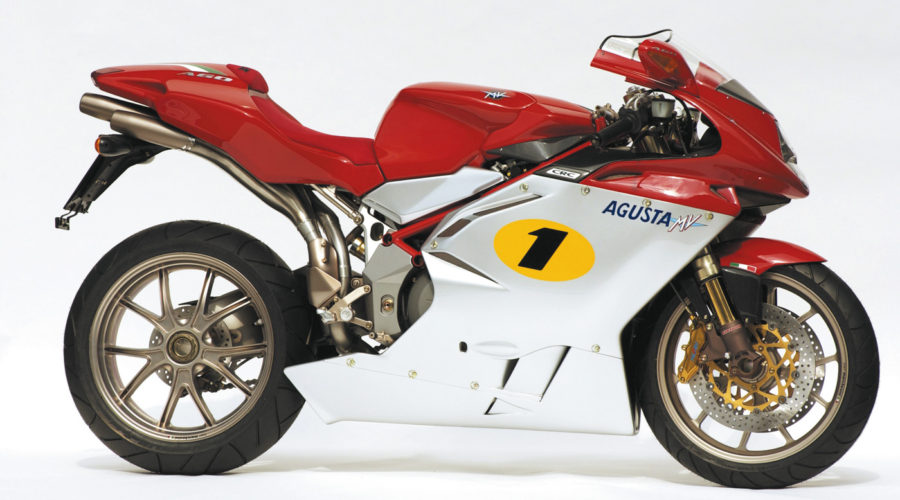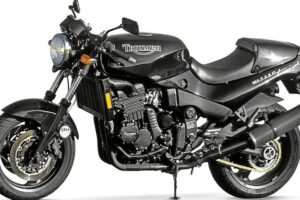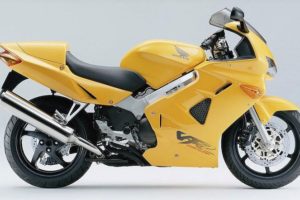2005 MV Agusta F4 1000 Agostini
This stunningly beautiful creature’s credentials go more than skin deep, for it is also the most powerful 1000cc sportsbike on the road.
Forget its claim of 122kW because it does one kilowatt more than that at the rear wheel. But before we open the throttle to feel that force, let’s enjoy the foreplay that is inherent in the design of the MV Agusta F4 1000 Agostini.
MV Agusta and Giacomo Agostini are irrevocably and evocatively linked through a history that includes eight 500cc world championships. It is one of motorcycling’s dream pairings, leading to years of domination of the sport and forever etching itself into the memories of millions of people. And it wasn’t just the winning that inspired everyone’s enthusiasm, for the MVs were exotic and technically advanced while the handsome and debonair Agostini added a romantic appeal.

Twenty nine years after the last of those eight titles, you can live your own tribute as the owner of one of the 300 limited-edition F4 Agostinis released to honour the great champion. Twenty of them will be sold in Australia, but if you reckon that’s not many, think again in light of the $52,000 price, which is about 20 grand more than the base model S.

That money buys you more than exclusivity. In addition to the Number 1 plates and the multitude of stickers bearing Ago’s name, the Ago adds value with better bits compared to the standard 1000S.
The Ago kit consists of a Corsa RG3 muffler with matched eprom chip (as well as the stock street-legal pipes), a bike cover, workshop stand, grip covers, a set of MV overalls and, in a not-so-subliminal way of encouraging you to spend more, a catalogue listing the rest of the MV accessory range. But it doesn’t end there. Eight components, including the front guard and inlet ducts, are carbon fibre, and the adjustable footrest hangers are of a classier design and finish than the stockers.
The Marzocchi forks cop nitrided sliders to reduce friction and the Marchesini magnesium wheels reduce unsprung weight by a few hundred grams. The front brake calipers are different too, milled from solid aluminium billet.
It comes in the red/silver colour scheme that is MV’s signature, has a red Alcantara (a suede-composite material) seat with the F4 logo embroidered into it, titanium paint finish on various parts and a gold plate on the top triple clamp with the individual bike’s serial number (X of 300) and Ago’s signature.

All up, the Ago is a couple of kilos lighter than the 1000S and, with its race pipe fitted, a few kilowatts more powerful.
And it flies! The engine is actually lighter than the 750’s, and most of that mass is taken from reciprocating parts so it revs very quickly, too. It loves to rev, the slick-changing close ratio gearbox enabling you to glue the tacho needle into the upper end of the 12,700 rpm range. Peak power comes in just before 12,000 rpm and anything above 10,000 rpm is an adrenalin rush accompanied by a spine-tingling howl of intake and exhaust.
The midrange is also good and low-end torque is great, but behaviour below 4000 rpm is disappointing, with fluffy power and a willingness to stall at times as you coast to a halt. There’s scope to tune the fuelling below 5000 rpm, but the real problem, as we found on Dyno Dave’s rolling road, is that the eprom chip seems to be set for European fuel. Fed our lower-grade petrol, the MV runs poorly down low and very rich through the top end. Imagine the potential power and sweet running if you add, say, a Power Commander and tune it properly.

MV designed a very adjustable chassis to cope with the power delivery. The 50 mm Marzocchi forks feature the usual adjustments while the Sachs Racing shock gets the norm as well as adjustable high-speed compression damping. Ride height is easily changed, and if you’re very keen you could experiment with different swingarm pivot heights, though that’s not such a simple adjustment.
Standard, the MV sits low at the rear for a stable and pretty plush road ride. Steering isn’t bad (the front tyre is a slower-turning 120/70, not the 120/65 the 750 had and the 1000 could have) but if you’re on the pace you ‘ll need to raise the rear ride height at least 25 mm. This improves rear traction, too.
I discover this during testing at the track. At first I struggle with a very slippery back end, but soon I’ve raised the ride height, reached maximum preload and maximum rebound damping, and done just a few tweaks of the excellent forks. I’d need to alter the shock’s settings (an operation Terry Hay at Shock Treatment says would be easy within the unit’s existing design) to get that last bit of perfection.
The result is a slight amount of rear wheel sliding coming into the apex of a corner sometimes but otherwise sheer bliss and fun.

The MV steers superbly, on road or track, slicing so smoothly into a bend that no one will beat you to the apex. The transition from upright to full lean is completely stable yet very quick and encourages you to carry massive cornering speeds. It’s also willing to let you brake long past the point of comfort for other bikes, hence you can get on the brakes a bit later.
Once I pause briefly to ensure the back is gripping, the MV lets me open the throttle gradually but firmly. It’s sometimes a difficult moment, for the throttle is a little heavy (not at all like the 750’s was) and the fuelling comes on abruptly, so you must be careful. Yet not once does it fail me dangerously; rather, I err on the side of caution and end up cursing for letting speed drop further.
As the MV comes upright under power, the thing just goes. At one point I’m gently powersliding the rear when the front lifts. Yee-ha!
As speed builds I must be quick on the gears, but that’s easy. I tuck behind the screen into more protection than I expected considering that, by 130 km/h, when sitting upright, the wind force was strong; on the road it takes weight off wrists, making the sporty riding position more pleasant.
The next bend rushes up and I hammer the brakes. The lever is spongy and vague, using most of its travel – typical of previous MVs – but the calipers and discs team up to take up the slack, with demon power. Stability under brakes is excellent, aided partly by the electronic system that subtly reduces the engine braking effect on the rear wheel.
The MV doesn’t feel like 190 kg and is probably less than 180kg when compared with Japan’s version of a ‘dry’ weight. It’s agile on the move like a lighter bike.
Despite the heavy initial action of the throttle, the harsh throttle response and the not-quite-perfect traction, the Ago’s onboard lap timer tells me it has helped me to a new personal lap record at Eastern Creek on a stock bike: 1:44.9. That’s how good it is. Despite some flaws in the system it’s still a faster sportsbike than its rivals. You’ve got to love that.

As I continue the test on the road, on familiar bumps and stability-testing surfaces, the Ago continues to impress. And I realise also that my perceptions of the slides from the rear are probably exaggerated because this time all feedback comes clearer than ever before. I discover that one of the chassis’ secrets is a hypersensitive feel for the road and an ability to communicate it distinctly.
I’d have liked to reduce the high-speed damping to improve bump-hitting comfort with the back jacked up like this, but it’s already at its softest setting from the factory and is, presumably, intended to increase control as loads increase. But on a solo-seat bike?
There are more complaints. Vibration, especially at 4000-6000 rpm, can be a hand-numbing bitch. Fuel consumption is very high in its imperfect state of tune, the classy toolkit neglects a screwdriver for suspension adjustment, your thumbs will still get caught between ‘bars and bike at full lock, and that lock provides the turning circle of a barge. But as the MV’s ultimate performance outstrips its drawbacks, so do the bike’s arousing design and detail make its flaws shrink into the background.

The fairing and seat unit come off in seconds thanks to quick-release clips, and the tank follows moments later. There is no end of beautiful detail to admire, from the sexy exhaust to the elegant, adjustable footrest brackets. Pedals, levers and the Ohlins steering damper are all adjustable, too. The Alcantara seat cloth provides good grip on your bum without restricting motion.

MV’s new 1000cc sportsbike is a special machine, a motorcycle above and beyond the mainstream motorcycles on the market today, and the Ago is an extra special version of it with its own inimitable appeal. Sure, the price is high but so too are the cachet, the performance and the pleasure. If you are tempted and want to be persuaded, let me put it to you this way: Just as there will never again be that MV/Ago combination that made history and is still revered today, there may never again be a chance for such an exotic and intoxicating motorcycle in your future, and you will revere it come the day that it is in your past.
By Mick Matheson. Two Wheels, December 2004

The Ago vs the 1000S
In terms of outright performance, you won’t be faster on an Ago than a 1000S unless you’re blessed with the skills of a top-level A-grade rider.
The marginally lighter wheels and slipperier fork action provide the key differences, especially if you can afford to buy an RG3 muffler for your 1000S. Even with a stock pipe, the 1000S should be at least the peak-power equal of the best Japanese 1000s and it will, judging from our experience with the Ago and previous 750s, outhandle them, too.

Is the Ago worth the extra cash? Yes, but barely, and then only if you can afford it. But spend that $20,000 difference on the right modifications for a stock 1000S and you would have an incredible performance weapon.
Or settle for a stocker at $32,900 and leave it at that. Few could want for more.
By Mick Matheson. Two Wheels, December 2004

Ian Falloon offers these comments on MV F4 1000 prices today: “So few were sold, it would depend upon the mileage and condition. An Ago could be 25K-plus and the 1000S 10-20K.”
Ian Falloon is one of the world’s foremost motorcycle historians and authorities on classic motorcycle provenance and authenticity. He has written many books on classic and collectable motorcycles, including The Book of the Classic MV Agusta Fours, and the upcoming The MV Agusta Story, both available here.

Guido from AllMoto has a detailed look at the revival of the MV Agusta marque in 1997, with the release of the first F4 750, the bike that preceded the F4 1000, including comments from designer Massimo Tamburini and Two Wheels tester, and Grand Prix rider, Kevin Magee, who rode the bike at its launch. Guido also covers potential issues with a used example, assesses its potential as a future collectable, and has a guide to what you can expect to pay here.




